Breast Implant Market Size 2024-2028
The breast implant market size is forecast to increase by USD 595.9 million, at a CAGR of 5.3% between 2023 and 2028.
- The market is a significant and dynamic sector in the healthcare industry, characterized by continuous evolution and growth. This market caters to the increasing prevalence of breast cancer survivors seeking reconstruction and cosmetic procedures for aesthetic enhancement. Two primary approaches, organic and inorganic, are adopted by market participants to expand their presence and meet the evolving demands. Organic growth strategies include research and development investments, product innovation, and strategic collaborations. Inorganic growth, on the other hand, is achieved through mergers, acquisitions, and partnerships. Despite these strategies, the market faces challenges, including the potential for complications associated with implant usage.
- Comparing the market's growth trends, there has been a noticeable increase in demand for textured implants, accounting for approximately 60% of the global market share. Smooth implants, accounting for the remaining 40%, have seen a decline in popularity due to the higher risk of breast implant-associated anaplastic large cell lymphoma (BIA-ALCL) with textured implants. This shift in consumer preference underscores the importance of innovation and product development in the market. Market players must navigate this dynamic landscape, addressing consumer concerns, adhering to regulatory requirements, and capitalizing on emerging trends to maintain a competitive edge. The ongoing unfolding of market activities and evolving patterns necessitate a proactive and strategic approach from industry participants.
Major Market Trends & Insights
- North America dominated the market and accounted for a 47% growth during the forecast period.
- The market is expected to grow significantly in Europe as well over the forecast period.
- By the Product, the Silicone breast implants sub-segment was valued at USD 1540.80 million in 2022
- By the Application, the Breast cosmetic surgery sub-segment accounted for the largest market revenue share in 2022
Market Size & Forecast
- Market Opportunities: US $ 44.58 million
- Future Opportunities: US $595.9 million
- CAGR : 5.3%
- North America: Largest market in 2022
What will be the Size of the Breast Implant Market during the forecast period?
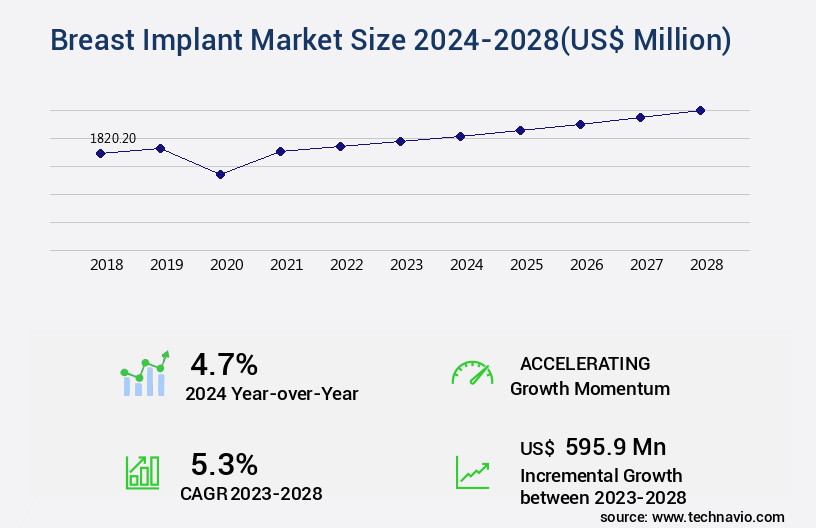
Get Key Insights on Market Forecast (PDF) Request Free Sample
- The breast implant industry continues to experience steady innovation driven by advancements in medical aesthetics and surgical technology. Implants are widely used for both cosmetic augmentation and reconstructive surgeries, with silicone gel and saline implants remaining the dominant options due to their durability, safety profiles, and natural appearance. Continuous developments in implant materials and surface texturing have improved biocompatibility, reducing risks of complications such as capsular contracture.
- Growing consumer demand for personalized aesthetic solutions is influencing implant design, leading to the introduction of form-stable implants, 3D imaging-based customization, and minimally invasive techniques. These trends align with broader growth in the medical devices and plastic surgery market, where technological integration is a key differentiator. Additionally, regulatory compliance and post-surgery monitoring solutions are shaping market strategies, ensuring patient safety and long-term performance.
- Recent industry insights indicate that implant-based procedures account for over 60% of cosmetic breast surgeries globally, reflecting strong market acceptance. With rising awareness and a focus on natural aesthetics, the market is expected to grow by approximately 8% in the coming years. Related innovations in biocompatible materials and minimally invasive surgical tools also create synergies with the Biomaterials Market and the Reconstructive Surgery Market, enhancing the overall ecosystem.
How is this Breast Implant Industry segmented?
The breast implant industry research report provides comprehensive data (region-wise segment analysis), with forecasts and estimates in "USD million" for the period 2024-2028, as well as historical data from 2018-2022 for the following segments.
- Product
- Silicone breast implants
- Saline breast implants
- Application
- Breast cosmetic surgery
- Breast reconstruction surgery
- Shape
- Round
- Anatomical
- Round
- Anatomical
- End-User
- Hospitals
- Cosmetology Clinics
- Ambulatory Surgical Centers
- Surface Type
- Size
- Geography
- North America
- Europe
- APAC
- Australia
- China
- Japan
- South Korea
- Rest of World (ROW)
By Product Insights
The silicone breast implants segment is estimated to witness significant growth during the forecast period.
Breast implants, filled with silicone gel, are widely used in both cosmetic augmentation and reconstructive procedures for women aged 22 and above. These implants offer a natural appearance and are designed with implant shell integrity in mind, making them firm, pliable, and lightweight. However, they come with certain risks, such as silent rupture, which necessitates regular imaging tests like magnetic resonance imaging (MRI) or ultrasound screening every three years for early detection. Implant fill material quality and implant material composition play a vital role in minimizing complication risk factors and ensuring long-term implant stability.
The market for breast implants is expansive, featuring various design options such as anatomical implant designs and round implant designs. Surgical incision planning and tissue pocket creation are critical steps in achieving optimal results, along with implant placement techniques and surgical technique variations that influence aesthetic symmetry assessment. Implant volume selection, implant shape selection, and anesthesia protocols are important considerations in preoperative imaging protocols and surgical planning software.
Clinical trial outcomes and breast implant registry data provide insights into complication risk factors, including capsular contracture, implant deflation management, and wound healing assessment. According to recent studies, approximately 10% of women experience capsular contracture, emphasizing the need for prevention strategies and post-operative monitoring. Patient education materials and informed consent processes are essential to address patient age considerations, body mass index influence, and tobacco use impact on outcomes. Postoperative recovery time, surgical drain management, and scar revision techniques further contribute to patient satisfaction surveys and long-term safety.
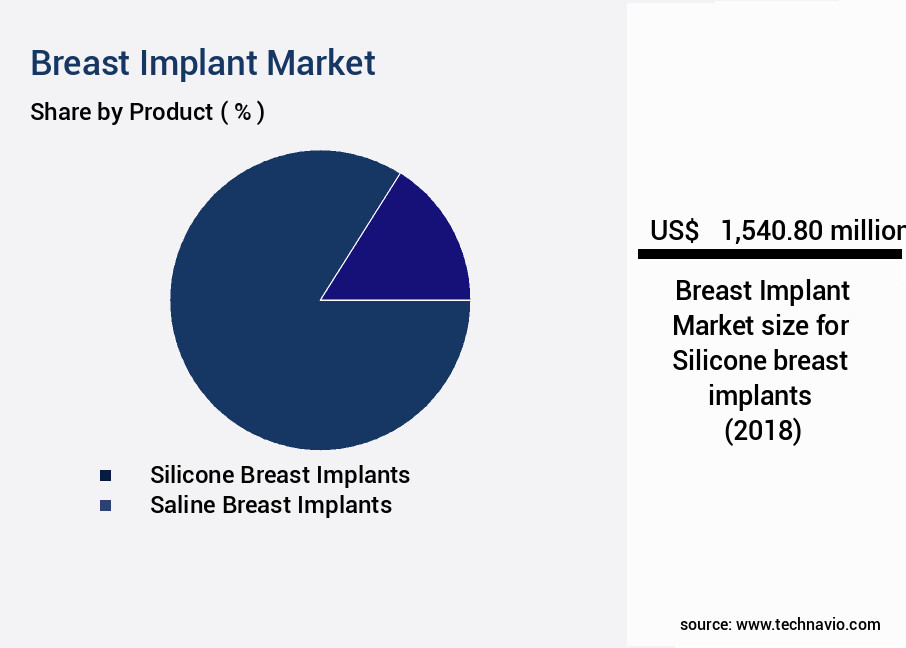
The Silicone breast implants segment was valued at USD 1540.80 million in 2018 and showed a gradual increase during the forecast period.
Quality control measures, implant manufacturing processes, and advanced implant material composition ensure compliance with safety standards while reducing risks related to silicone allergy testing. Continuous innovation in implant shell integrity, infection prevention protocols, and capsular contracture prevention reflects the market's evolution toward safer, more effective solutions.
Infection prevention protocols and surgical revision procedures are essential to mitigate these risks. The market for breast implants is expected to grow substantially, with an estimated 15% of women in developed countries considering breast augmentation at some point in their lives. This trend is driven by factors such as increasing awareness, evolving societal norms, and advancements in technology and surgical techniques. In conclusion, the market is a complex and evolving industry, with ongoing advancements in design, materials, and surgical techniques. It is essential to consider various factors, including patient selection criteria, implant complications management, implant malposition correction, aesthetic outcomes assessment, and implant longevity studies, to ensure optimal patient safety and satisfaction.
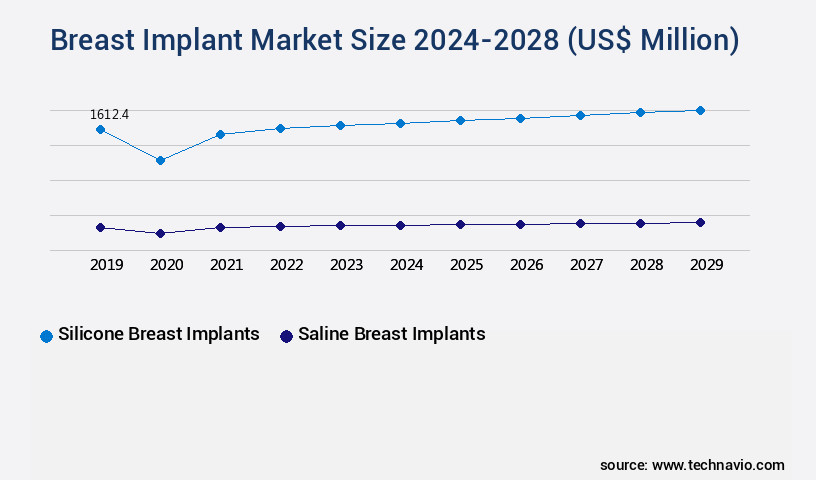
Request Free Sample
Regional Analysis
North America is estimated to contribute 47% to the growth of the global market during the forecast period.Technavio's analysts have elaborately explained the regional trends and drivers that shape the market during the forecast period.
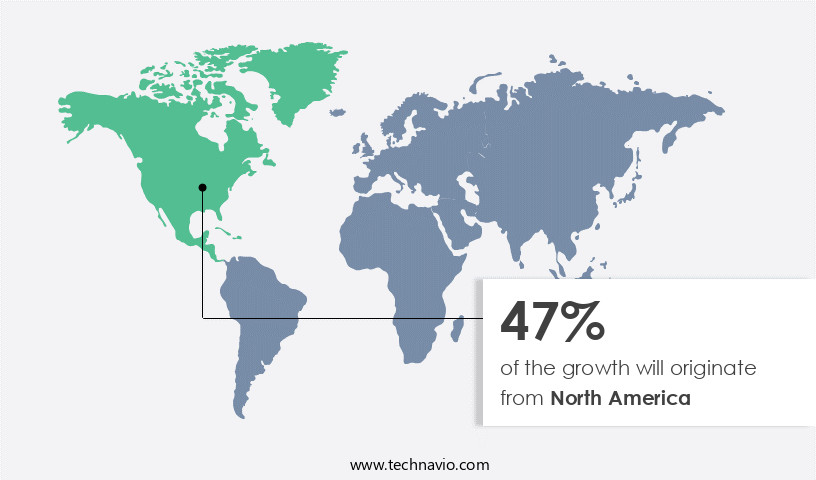
See How Breast Implant Market Demand is Rising in North America Request Free Sample
The market in North America is experiencing significant growth, fueled by the region's well-established healthcare infrastructure, extensive insurance coverage, and the availability of highly skilled professionals. The increasing popularity of cosmetic surgical procedures, such as breast augmentation, among women seeking to enhance their appearance, coupled with the adoption of advanced technological products and less invasive treatments, is further driving market expansion. According to recent industry reports, the market in North America is projected to grow at a steady pace, with an anticipated increase of approximately 5% in annual sales in the coming years. This growth is attributed to the rising number of cosmetic surgical procedures and the increasing acceptance of breast implants as a viable option for enhancing body image and self-confidence.
Compared to other regions, North America's the market growth outpaces that of Europe and Asia Pacific, where market expansion is driven by factors such as increasing awareness and affordability. In Europe, for instance, the market is expected to grow at a moderate pace, with a projected annual growth rate of around 3%, while in Asia Pacific, the market is projected to grow at a rate of approximately 4%. These trends highlight the dynamic and evolving nature of the market, with North America leading the way in terms of growth and innovation.
Market Dynamics
Our researchers analyzed the data with 2023 as the base year, along with the key drivers, trends, and challenges. A holistic analysis of drivers will help companies refine their marketing strategies to gain a competitive advantage.
The global breast implants market continues to evolve with advancements in implant technology and surgical techniques. Silicone gel implant rupture detection methods have become increasingly sophisticated, incorporating MRI characteristics of different implant types and the role of ultrasound in detecting implant rupture to ensure patient safety. Long-term stability of saline breast implants and the comparison of anatomical and round implant designs are critical factors influencing preoperative patient selection for breast augmentation. Surgical techniques for breast implant revision and management of implant-related complications focus on reducing risks and improving patient outcomes.
Risk factors for capsular contracture following surgery account for approximately 10% of post-implant complications, highlighting the importance of infection prevention strategies during implant surgery and postoperative pain management strategies. Studies assessing the impact of implant placement on breast tissue and the impact of implant volume on aesthetic outcome help surgeons tailor surgical planning. Patient satisfaction with different implant shapes and patient-reported outcomes after breast implant surgery indicate a 92% satisfaction rate for properly selected implants.
Longitudinal study of breast implant longevity and assessment of breast implant biocompatibility drive innovation in implant design. Comparison of different incision medical techniques and the impact of body mass index on implant outcome are essential considerations for achieving optimal aesthetic symmetry. Mammography interpretation in patients with implants remains a critical aspect of ongoing care, ensuring accurate screening and early detection of complications.
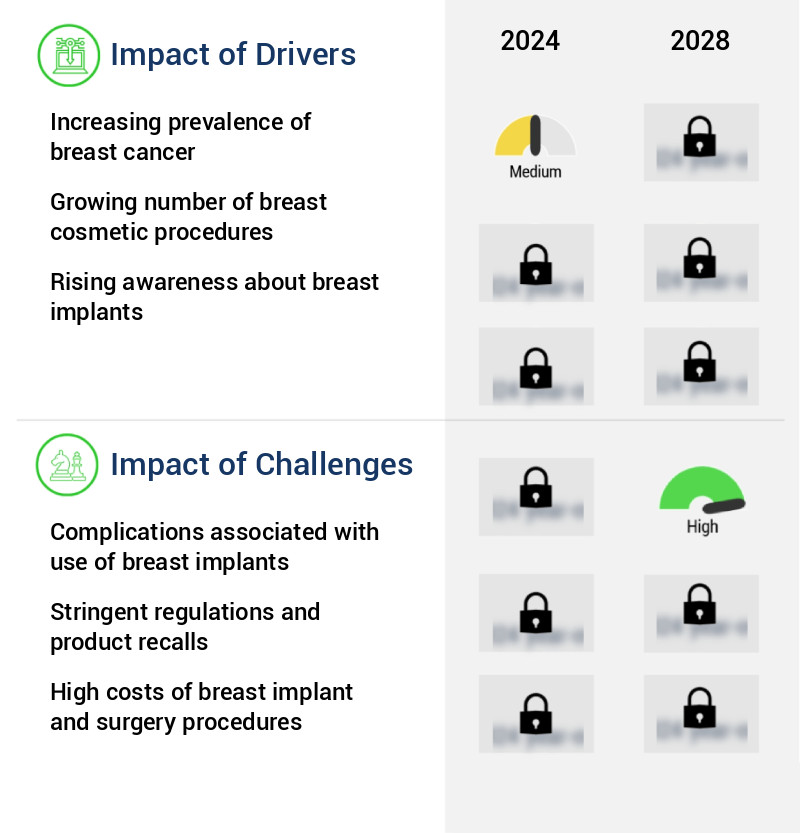
What are the key market drivers leading to the rise in the adoption of Breast Implant Industry?
- The rising prevalence of breast cancer serves as the primary market driver, significantly influencing industry growth.
- The market encompasses a diverse range of products and applications, serving both medical and cosmetic sectors. These implants are designed to enhance or reconstruct the appearance of breasts, primarily used in breast augmentation and reconstruction surgeries. The market's continuous evolution is driven by advancements in technology, increasing demand for aesthetic enhancements, and growing awareness about breast reconstruction following mastectomies due to breast cancer. According to market data, The market size was valued at approximately USD 6.8 billion in 2018, with a steady growth trajectory. Silicone implants held the largest market share, accounting for over 70% of the total market.
- Saline implants, on the other hand, accounted for around 25% of the market share. The remaining market share was attributed to other types of implants, such as polypropylene and soy-based implants. Despite the differences in market share, both saline and silicone implants cater to distinct patient preferences and requirements. Saline implants offer the advantage of being less expensive and easier to insert, while silicone implants provide a more natural look and feel. The choice between the two largely depends on individual preferences, surgical considerations, and patient comfort. The market's future growth is expected to be driven by increasing awareness and acceptance of cosmetic procedures, advancements in implant technology, and the rising prevalence of cancer and subsequent reconstructive surgeries. This ongoing market activity underscores the importance of the breast implant industry and its role in enhancing and restoring breast appearance.
What are the market trends shaping the Breast Implant Industry?
- Market trends indicate that market players are adopting both organic and inorganic strategies. The market is a dynamic and evolving industry, characterized by continuous growth and innovation. Companies in this sector are employing various strategies to expand their market share and global presence. These strategies include mergers and acquisitions, partnerships, product launches, and consolidating supply chain networks with distributors. Leading companies in the market are focusing on improving their product offerings and technologies to maintain a competitive edge. For instance, in February 2018, POLYTECH Health Aesthetics collaborated with AMSilk GmbH to conduct clinical studies on silk-coated silicone SILKline breast implants. This partnership aimed to enhance the safety and efficacy of the implants.
- Moreover, small firms in the market are thriving through innovation. They are introducing advanced technologies and materials to cater to the diverse needs of consumers. For example, some firms are offering textured implants that mimic the natural feel and shape of breast tissue. Others are focusing on developing implants with reduced complications and improved safety profiles. Despite the competition, the market continues to grow, driven by increasing consumer awareness and acceptance of cosmetic procedures. According to recent reports, The market was valued at over USD3 billion in 2020 and is projected to reach over USD5 billion by 2026, growing at a significant pace.
- This growth is attributed to factors such as rising disposable income, increasing awareness of body image, and advancements in technology. In conclusion, the market is a thriving industry, marked by constant innovation and competition. Companies are adopting various strategies to expand their presence and improve their offerings, while consumers continue to seek advanced and safe solutions for breast augmentation. The market's growth is driven by various factors, including increasing consumer awareness, acceptance of cosmetic procedures, and technological advancements.
What challenges does the Breast Implant Industry face during its growth?
- The use of breast implants presents significant complications that pose a challenge to the growth of the industry. These complications, which can include capsular contracture, implant rupture, and the potential for breast cancer, require ongoing research and innovation to mitigate their impact and ensure patient safety.
- Breast implants have been a subject of significant interest in the global healthcare sector due to their widespread use and potential complications. These implants, employed for various reasons such as reconstruction, aesthetic enhancement, and medical purposes, can lead to various complications that influence patient satisfaction, safety perceptions, and market dynamics. Physical complications include pain, swelling, bleeding, and infection. Capsular contracture, characterized by the hardening of scar tissue around the implant, is another common issue. Implant rupture, which can occur silently with silicone implants, is a concern due to potential health risks. Aesthetic concerns are another category of complications.
- Patients may experience dissatisfaction with asymmetry, visible wrinkling, or changes in breast shape over time, necessitating additional corrective surgeries. Moreover, breast implants pose serious health risks. A rare but significant complication is breast implant-associated anaplastic large-cell lymphoma (BIA-ALCL), a type of cancer linked to textured implants. These complications underscore the importance of ongoing research and development in the market. Manufacturers and healthcare providers work together to improve implant materials, surgical techniques, and patient education to minimize risks and enhance patient outcomes. The market continues to evolve, with new technologies and innovations addressing these challenges and shaping the future of breast implant applications.
Exclusive Customer Landscape
The breast implant market forecasting report includes the adoption lifecycle of the market, covering from the innovator's stage to the laggard's stage. It focuses on adoption rates in different regions based on penetration. Furthermore, the breast implant market report also includes key purchase criteria and drivers of price sensitivity to help companies evaluate and develop their market growth analysis strategies.
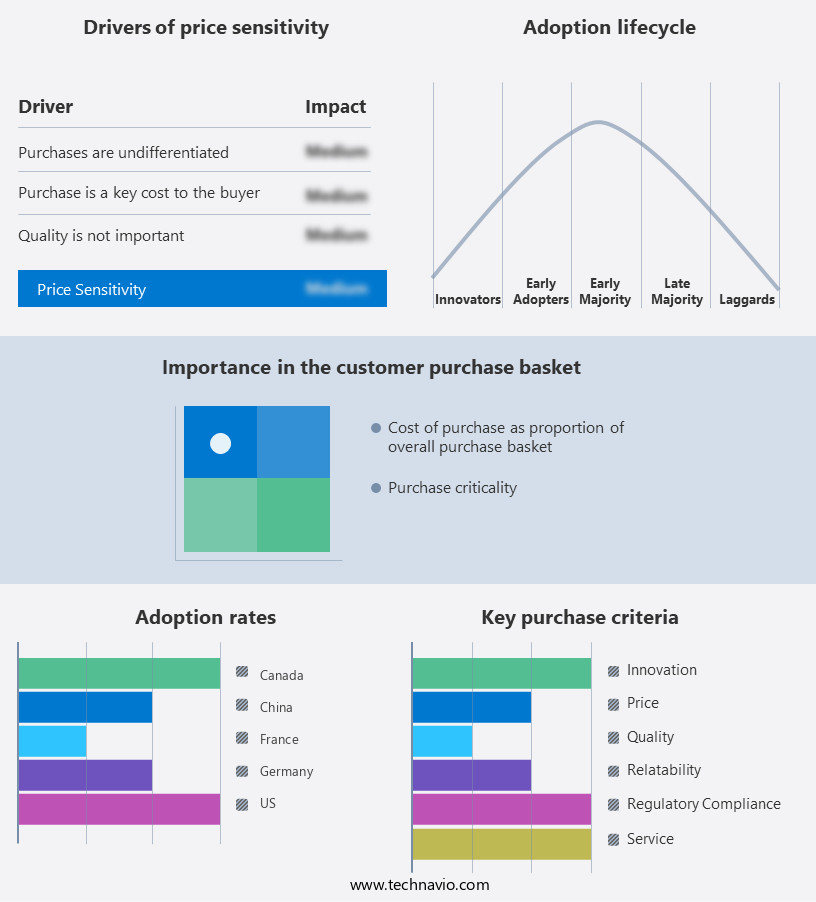
Customer Landscape of Breast Implant Industry
Key Companies & Market Insights
Companies are implementing various strategies, such as strategic alliances, breast implant market forecast, partnerships, mergers and acquisitions, geographical expansion, and product/service launches, to enhance their presence in the industry.
aAbbVie Inc. (United States) - This company specializes in providing diverse breast implant solutions, featuring five distinct profile options and three innovative gummy gel types. These offerings cater to various customer preferences, enhancing the customization of aesthetic procedures.
The industry research and growth report includes detailed analyses of the competitive landscape of the market and information about key companies, including:
- aAbbVie Inc. (United States)
- BellaSeno GmbH (Germany)
- CollPlant Biotechnologies Ltd. (Israel)
- DONASIS BIO LABO (South Korea)
- Establishment Labs Holdings Inc. (Costa Rica)
- Global Consolidated Aesthetics Ltd. (United Kingdom)
- Groupe SEBBIN SAS (France)
- Guangzhou Wanhe Plastic Materials Co. Ltd. (China)
- Johnson and Johnson Services Inc. (United States)
- Laboratoires Arion (France)
- PMT Corp. (United States)
- POLYTECH Health and Aesthetics GmbH (Germany)
- Sientra Inc. (United States)
- Silimed Industria de Implantes Ltd. (Brazil)
- Technomed India Pvt. Ltd. (India)
- Trulife (Ireland)
Qualitative and quantitative analysis of companies has been conducted to help clients understand the wider business environment as well as the strengths and weaknesses of key industry players. Data is qualitatively analyzed to categorize companies as pure play, category-focused, industry-focused, and diversified; it is quantitatively analyzed to categorize companies as dominant, leading, strong, tentative, and weak.
Recent Development and News in Breast Implant Market
- In January 2024, Allergan Aesthetics, a leading player in the market, announced the FDA approval of its new textured implant, Natrelle Inspira, designed to reduce the risk of breast implant-associated anaplastic large cell lymphoma (BIA-ALCL) (Allergan Aesthetics Press Release).
- In March 2024, Sientra, Inc. And Mentor Worldwide LLC, two major breast implant manufacturers, entered into a definitive agreement to merge, creating a leading global medical aesthetics company (Business Wire). The combined entity, to be named Enhance Medical Group, aimed to expand its product offerings and geographic reach.
- In May 2024, the European Commission approved the marketing authorization application for Sebbin Implants, a new entrant in the European the market, marking its entry into the competitive landscape (European Commission Press Release).
- In April 2025, Silimed, a Brazilian breast implant manufacturer, raised USD50 million in a Series C funding round, led by Sofinnova Partners, to support the expansion of its production capacity and global market penetration (Silimed Press Release).
Research Analyst Overview
- The market encompasses a diverse range of products and services, with ongoing advancements shaping its applications across various sectors. Anatomical implant designs continue to evolve, addressing individual patient needs and preferences. For instance, round implants offer a more uniform appearance, while textural implant types mimic the natural feel and look of breast tissue. Implant volume selection and shape are crucial considerations, with patients seeking optimal results. However, these choices come with risks, such as implant deflation, rupture, and capsular contracture. Biocompatibility testing and surgical implant removal procedures are essential to mitigate complications, including silicone allergy and implant malposition. Mammography imaging changes due to breast implants necessitate ongoing research to ensure accurate detection and diagnosis.
- Postoperative pain control methods and infection prevention protocols are also crucial to enhance patient satisfaction and safety. Ultrasound imaging techniques and MRI detection capabilities further contribute to the assessment of aesthetic outcomes and implant longevity studies. The market's growth is driven by increasing consumer awareness and demand for breast augmentation and reconstruction procedures. This expansion is attributed to factors such as rising disposable income, growing acceptance of cosmetic surgery, and technological advancements in implant materials and designs.
- Despite these advancements, challenges persist, including implant complications management, implant rupture detection, and surgical revision procedures. Addressing these challenges requires continuous research and innovation to ensure the safety and efficacy of breast implant products and services.
Dive into Technavio's robust research methodology, blending expert interviews, extensive data synthesis, and validated models for unparalleled Breast Implant Market insights. See full methodology.
|
Market Scope
|
|
Report Coverage
|
Details
|
|
Page number
|
161
|
|
Base year
|
2023
|
|
Historic period
|
2018-2022 |
|
Forecast period
|
2024-2028
|
|
Growth momentum & CAGR
|
Accelerate at a CAGR of 5.3%
|
|
Market growth 2024-2028
|
USD 595.9 million
|
|
Market structure
|
Fragmented
|
|
YoY growth 2023-2024(%)
|
4.7
|
|
Key countries
|
US, China, France, Canada, Germany, Japan, South Korea, Australia, and Rest of World
|
|
Competitive landscape
|
Leading Companies, Market Positioning of Companies, Competitive Strategies, and Industry Risks
|
Request Free Sample
What are the Key Data Covered in this Breast Implant Market Research and Growth Report?
- CAGR of the Breast Implant industry during the forecast period
- Detailed information on factors that will drive the growth and forecasting between 2024 and 2028
- Precise estimation of the size of the market and its contribution of the industry in focus to the parent market
- Accurate predictions about upcoming growth and trends and changes in consumer behaviour
- Growth of the market across North America, Europe, Asia, and Rest of World (ROW)
- Thorough analysis of the market's competitive landscape and detailed information about companies
- Comprehensive analysis of factors that will challenge the breast implant market growth of industry companies
We can help! Our analysts can customize this breast implant market research report to meet your requirements.
Get in touch







![]() Get the report (PDF) sent to your email within minutes.
Get the report (PDF) sent to your email within minutes.
Complimentary full Excel data with your report purchase.